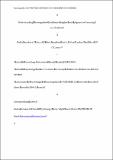Files in this item
Understanding metacognitive confidence : insights from judgment-of-learning justifications
Item metadata
| dc.contributor.author | Jersakova, Radka | |
| dc.contributor.author | Allan, Richard | |
| dc.contributor.author | Booth, Jonathan | |
| dc.contributor.author | Souchay, Celine | |
| dc.contributor.author | O'Connor, Akira Robert | |
| dc.date.accessioned | 2018-08-28T23:33:42Z | |
| dc.date.available | 2018-08-28T23:33:42Z | |
| dc.date.issued | 2017-12 | |
| dc.identifier | 250755431 | |
| dc.identifier | be6b4aac-4e8c-4b67-851b-a8657e630084 | |
| dc.identifier | 85028467183 | |
| dc.identifier | 000412265500012 | |
| dc.identifier.citation | Jersakova , R , Allan , R , Booth , J , Souchay , C & O'Connor , A R 2017 , ' Understanding metacognitive confidence : insights from judgment-of-learning justifications ' , Journal of Memory and Language , vol. 97 , pp. 187-207 . https://doi.org/10.1016/j.jml.2017.08.002 | en |
| dc.identifier.issn | 0749-596X | |
| dc.identifier.other | ORCID: /0000-0002-7943-5183/work/36476317 | |
| dc.identifier.uri | https://hdl.handle.net/10023/15899 | |
| dc.description | This research was supported by the Economic and Social Research Council Studentship awarded to Radka Jersakova [ES/J500215/1]. | en |
| dc.description.abstract | This study employed the delayed judgment-of-learning (JOL) paradigm to investigate the content of metacognitive judgments; after studying cue-target word-pairs, participants predicted their ability to remember targets on a future memory test (cued recognition in Experiments 1 and 2 and cued recall in Experiment 3). In Experiment 1 and the confidence JOL group of Experiment 3, participants used a commonly employed 6-point numeric confidence JOL scale (0–20–40–60–80–100%). In Experiment 2 and the binary JOL group of Experiment 3 participants first made a binary yes/no JOL prediction followed by a 3-point verbal confidence judgment (sure-maybe-guess). In all experiments, on a subset of trials, participants gave a written justification of why they gave that specific JOL response. We used natural language processing techniques (latent semantic analysis and word frequency [n-gram] analysis) to characterize the content of the written justifications and to capture what types of evidence evaluation uniquely separate one JOL response type from others. We also used a machine learning classification algorithm (support vector machine [SVM]) to quantify the extent to which any two JOL responses differed from each other. We found that: (i) participants can justify and explain their JOLs; (ii) these justifications reference cue familiarity and target accessibility and so are particularly consistent with the two-stage metacognitive model; and (iii) JOL confidence judgements do not correspond to yes/no responses in the manner typically assumed within the literature (i.e. 0–40% interpreted as no predictions). | |
| dc.format.extent | 21 | |
| dc.format.extent | 1674445 | |
| dc.language.iso | eng | |
| dc.relation.ispartof | Journal of Memory and Language | en |
| dc.subject | Metacognition | en |
| dc.subject | Judgments-of-learning | en |
| dc.subject | Episodic memory | en |
| dc.subject | Confidence | en |
| dc.subject | Linguistics | en |
| dc.subject | BF Psychology | en |
| dc.subject | NDAS | en |
| dc.subject | BDC | en |
| dc.subject.lcc | BF | en |
| dc.title | Understanding metacognitive confidence : insights from judgment-of-learning justifications | en |
| dc.type | Journal article | en |
| dc.contributor.institution | University of St Andrews. School of Psychology and Neuroscience | en |
| dc.identifier.doi | https://doi.org/10.1016/j.jml.2017.08.002 | |
| dc.description.status | Peer reviewed | en |
| dc.date.embargoedUntil | 2018-08-29 |
This item appears in the following Collection(s)
Items in the St Andrews Research Repository are protected by copyright, with all rights reserved, unless otherwise indicated.

